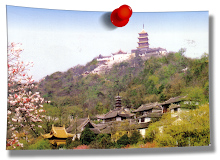

It was founded as the first Hungarian Benedictine monastery in 996 by Prince Géza, who designated this as a place for the monks to settle, and then it soon became the centre of the Benedictine order. The monastery was built in honour of Saint Martin of Tours. Géza's son, King Stephen I donated estates and privilege to the monastery. Astrik (Anastasius) served as its first abbot.
The oldest surviving document to use Hungarian language, the Charter of the Tihany Benedictine Abbey, dating back to 1055, is still preserved in the library. The first buildings of the community were destroyed, then rebuilt in 1137. The Basilica's pillars and the early Gothic vault were built in the early XIII century, using the walls of the former church. In 1486 it was reconstructed under King Matthias in Gothic style.
The monastery became an archabbey in 1541 and as a result of Ottoman incursions into Europe in the 16th and 17th centuries, it was turned into a fortification. During one and a half centuries of the Turkish Occupation, the monks, however, had to abandon the abbey for shorter or longer periods of time. Only later were they able to start the reconstruction of the damaged buildings. During the time of Archabbot Benedek Sajghó, a major baroque construction was in progress in the monastery.
In the 17th and 18th centuries, rich Baroque adornments and extensions were added to the complex and much of its current facade dates from this time. It received its present form in 1832, with the library and the tower, which was built in classicistic style. The 18th century, the era of the Enlightenment also influenced the life of the monasteries. The state and the monarchs judged the operation of the communities according to immediate utility, by and large tolerating only those orders which practised nursing and education. In the 1860s, Ferenc Storno organised major renovations, mostly in the basilica.
After 1945 the properties of the Order and the schools run by the Benedictines were confiscated by the communist state from 1950 until the end of communism in Hungary. In 1995, one year before the millennium, the complex was entirely reconstructed and renovated. In 1996, "the Millenary Benedictine Abbey of Pannonhalma and its Natural Environment" was elected among the World Heritage sites.
Pannonhalma was visited, among others, by Alexius II, Patriarch of Moscow in 1994, Pope John Paul II in 1996 and Patriarch Bartholomew I of Constantinople and the Dalai Lama in 2000. In 2005, a film was made about the archabbot, Asztrik Várszegi, titled A közvetítő ("The mediator").











































